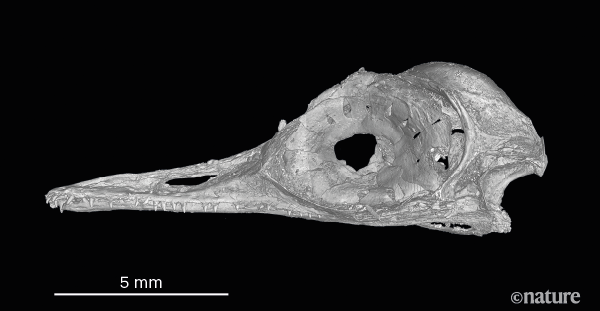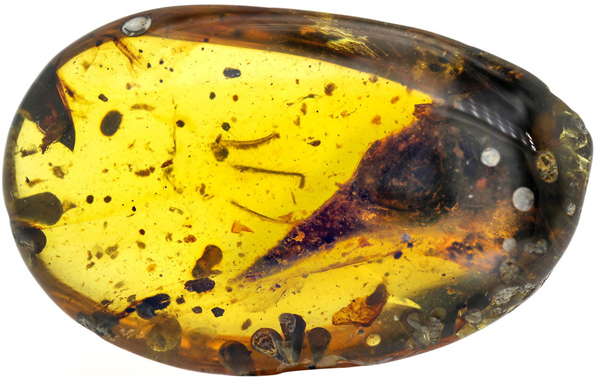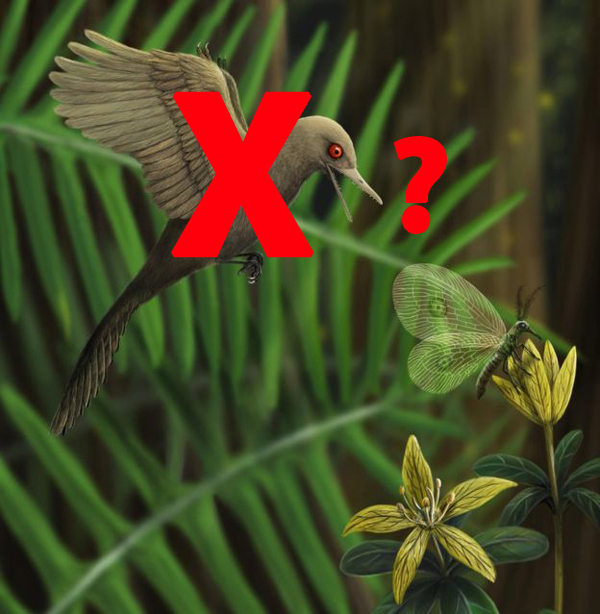Scientific Paper on Oculudentavis khaungraae Retracted
On March the 11th (2020), a scientific paper was published in the academic journal “Nature” highlighting another remarkable discovery found in an amber nodule from northern Myanmar. The Cretaceous-aged amber had already provided some astonishing information on the forest biota close to a coastline from around 100 million years ago.
An ammonite shell entombed in the ancient tree resin for example, then there was the remains of a tiny baby snake (Xiaophis myanmarensis), fossilised frogs and a whole range of insects, plant and pollen fossils, not to mention preserved remains of enantiornithine birds and a partial feathered tail from a dinosaur. Everything Dinosaur had covered these discoveries within this blog, but this new paper, written by Xing et al concerned something truly breath-taking… the title of the paper summed it up nicely – “Hummingbird-sized dinosaur from the Cretaceous period of Myanmar”.
A Tiny Fossilised Skull – The Skull of a Maniraptoran?
Picture credit: Lida Xing et al
Something Tiny But Very Big
The research team, comprised of scientists from the China University of Geosciences, the Natural History Museum of Los Angeles County (USA), the Royal Saskatchewan Museum (Canada) and the Chinese Academy of Sciences, described an amazingly well-preserved tiny fossil skull with very bird-like features but miniscule teeth present in its jaws. The tiny specimen, less than 1.5 cm long was thought to represent the smallest dinosaur known to science. The animal was named Oculudentavis khaungraae, the genus name means “eye tooth bird” in recognition of its enormous eyes and unusual characteristic of having some of the upper teeth located directly under the eye socket.
Computer Generated Image of the Bird-like Skull (O. khaungraae)

Picture credit: Xing et al (Nature)
Oculudentavis khaungraae was documented as representing the smallest dinosaur and compared to the smallest extant avian dinosaur Mellisuga helenae, the bee hummingbird.
However, in what we at Everything Dinosaur think is an unprecedented development, the scientific paper announcing this amazing discovery has, this week, been retracted.
A statement on the “Nature” website reads:
“We, the authors, are retracting this Article [the March 11th paper] to prevent inaccurate information from remaining in the literature. Although the description of Oculudentavis khaungraae remains accurate, a new unpublished specimen casts doubts upon our hypothesis regarding the phylogenetic position of HPG-15-3.
The specimen number HPG-15-3, is the holotype cranial material currently in the collection of the Hupoge Amber Museum in China.
A Controversial Scientific Paper
Shortly after the scientific paper’s publication, a number of academics challenged the conclusions drawn and criticised the authors for their taxonomic assessment which relates to Oculudentavis khaungraae being classified as “bird-like” and placed within the Avialae, a clade that includes elements of the Maniraptora (some theropod dinosaurs and birds).
It was suggested that the phylogenetic assessment carried out was too biased towards resolving the placement of Oculudentavis as a bird or a very closely related dinosaur, rather than considering other data sets that might resolve its position elsewhere. The “bird-like” skull is found in a number of lizards (examples of convergent evolution), several authors commented that the possibility of O. khaungraae being a lizard was discounted too quickly by the paper’s authors.
Everything Dinosaur reported these concerns and doubts in a follow up article to the original post about the scientific paper on March 15th (2020): Casting Doubt over Oculudentavis.
Can a Binomial Name be Obliterated?
It is rare for a scientific paper to be retracted, but occasionally this happens. Papers can be retracted for any of a number of reasons, but normally a retraction occurs when serious questions surrounding its veracity are identified. For example, a paper published in 1998 in the medical journal the “Lancet” by Wakefield et al reporting a link between the MMR vaccination and autism was retracted in 2012 following an extensive investigation. The British Medical Journal (BMJ), put out a press release stating that following the investigation it had been concluded that the paper implying a link between the MMR jab and autism was an “an elaborate fraud.”
Dr Fiona Godlee, BMJ Editor in Chief stated at the time:
“The MMR scare was based not on bad science but on a deliberate fraud” and that such “clear evidence of falsification of data should now close the door on this damaging vaccine scare.”
The scientific binomial name Oculudentavis khaungraae is now in limbo. It is a matter of record that the taxon name exists, but with the withdrawal of the paper, we at Everything Dinosaur are not sure what will happen. It probably falls within the remit of the International Commission on Zoological Nomenclature (ICZN), to produce a ruling on how to treat this taxon.
This development does not undermine the astonishing fossil discoveries being made as researchers study amber from Myanmar, it might help to bring into focus some of the ethical issues associated with the commercial mining and use of funds, but scientific reporting is essentially built on trust. Fossils have been frequently misidentified , as new evidence emerges so ideas, theories and hypotheses evolve and develop. Normally, scientists correct their findings in subsequent papers, to have a scientific paper retracted is highly unusual.
Oculudentavis khaungraae – A Taxon in Limbo
Picture credit: Han Zhixin with additional annotation by Everything Dinosaur
We shall await developments…
In the meantime, visit the Everything Dinosaur website: Everything Dinosaur.








Leave A Comment